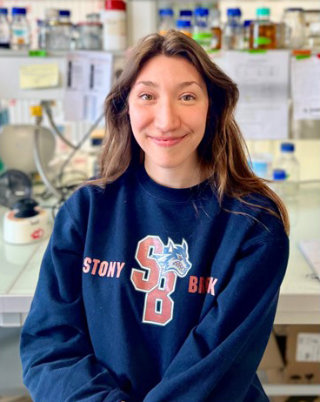Zuttion, SolèneWritten by: Sudheesh Allikka Parambil, Ph.D  Meet Solène Zuttion, a dedicated researcher currently pursuing a Ph.D. at the Integrative Molecular and Cellular Biology (IMCBio, Strasbourg, France) Graduate School of Research. Solène is passionate about the non-canonical functions of multi-localized aminoacyl-tRNA synthetases (aaRS) and is particularly fascinated by how these enzymes, primarily involved in cytosolic translation, can relocate to various organelles to perform diverse functions. Solène admires the research programs of Paul Fox (Cleveland Clinic, USA), Sunghoon Kim (Yonsei University, Korea), and Ignacio Luque (Spanish National Research Council, Spain), who focus on membrane-bound aaRSs. Solène earned her bachelor's and master's degrees from the University of Strasbourg, where she was inspired by exceptional biochemistry and genetics teachers such as Dr. Evelyne Myslinski, Prof. Philippe Carbon, and Prof. Serge Potier. "I also had a lot of structural biology courses, which insisted that the determination of the 3D structure of macromolecular complexes is essential to better understand at the atomic scale cellular processes in health and diseases." During her undergraduate years, Solène had the opportunity to work in Dr. Sylvie Friant's lab, using Saccharomyces cerevisiae as a model to study centronuclear myopathies, which ignited her passion for molecular biology and biochemistry. Currently, Solène is engaged in a Ph.D. project under the mentorship of Professor Hubert Becker and Dr. Sylvie Friant at IMCBio. Her research focuses on the dynamics and plasticity of the aminoacyl-tRNA synthetases, particularly the S. cerevisiae multi aminoacyl-tRNA synthetase AME complex. This project involves studying the relocalization and non-canonical functions of this complex, which includes the glutamyl- and methionyl-tRNA synthetases linked to the Arc1 cofactor. "By joining this program, I reached my first goal: an exciting PhD project, extra training, funding for abroad internships and meetings, and opportunities to organize summer schools with other Ph.D. students from the IMCBio graduate school."
Beyond research, Solène is deeply committed to science communication and outreach. "I teach enzymology and biochemistry to third-year bachelor's students. As one of my goals is to continue later with teaching activities besides research, it gives me a real insight into this responsibility, and I adore it!" Solène also participates in science festivals, explaining the use of yeast models to study diseases to school students and families. Additionally, as a member of the Women and Science association, she promotes women in scientific and technical careers by visiting high schools and leading workshops. Solène's favorite RNA is tRNA, closely tied to her research on aminoacyl-tRNA synthetases. She was particularly fascinated by tRNA-derived fragments (tRFs), a new class of small non-coding RNAs that play critical roles in gene expression regulation. Solène highlights an article from Lluís Ribas de Pouplana's lab published in the RNA Journal, which explores how tRFs regulate Adenosine deaminase acting on transfer RNA (ADAT) and its implications for diseases like microcephaly and epilepsy. She also appreciates the paper by Dr. Benoît Masquida from her own lab, which investigates the unique conformations of UNCG family loops in RNA structures. Solène emphasizes the importance of continuous learning and the privilege of having access to scientific knowledge. "The team and the persons in it make everything. Without them, I would not be sure to be featured today as an RNA society spotlight and I am more than grateful to them." As she continues her journey in RNA research, Solène remains committed to pushing the boundaries of molecular biology and inspiring future generations of scientists. |
